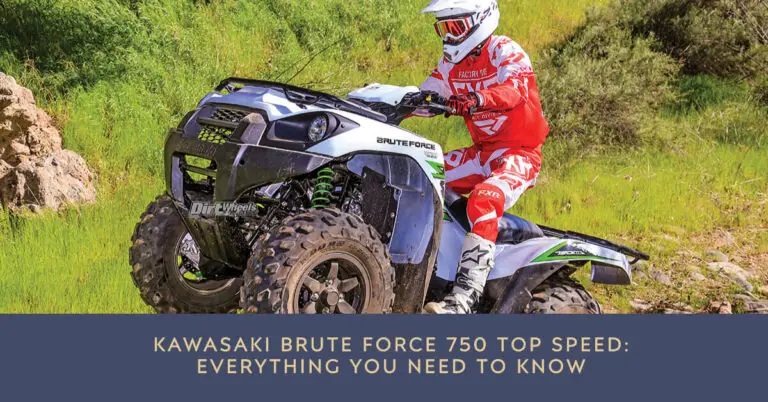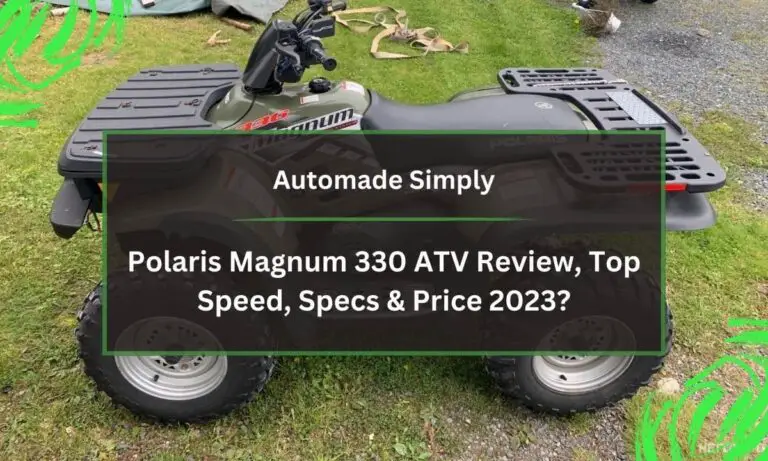How Fast Does a 125cc ATV Go? Speed and Performance Fully Explained

Have you ever wondered just how fast one of those small, entry-level 125cc ATVs can actually go? Or perhaps you’re an experienced rider looking to buy a new quad, and you want to know if a 125 has enough power for your needs.
Well, the top speed of a 125cc ATV is typically around 35-40 mph in stock form. With modifications and ideal conditions, some 125s are capable of reaching upwards of 40 mph. But raw top speed doesn’t tell the whole story when it comes to how these quads perform.
In this detailed guide, we’ll cover everything you need to know about 125cc ATV speeds, power, and capabilities:
- Typical top speed ranges for stock and modified 125cc ATVs
- Horsepower, torque, and acceleration expectations
- The factors that affect an ATV’s maximum velocity
- How 125s compare to larger 250cc, 400cc, and beyond ATVs
- Best performance modifications to make a 125cc go faster
- Is it safe or recommended to push 125s to the limit?
Let’s get started and see if the capabilities of these small ATVs will meet your needs and riding style!
Table of Contents
What Is The Top Speed Of An Average 125cc ATV?
One of the most common questions from new and prospective ATV riders is “how fast can I expect a 125cc quad to go?” Or they might wonder “what is the top speed of a 125 ATV?”
For a completely stock 125cc sport or utility ATV ridden under normal conditions, here are the top speeds you can typically expect:
- Recreational 125cc ATVs: 35-40 mph
- Utility style 125s: 35-40 mph
- Sport model 125cc quads: 35-40 mph
These speed estimates assume the ATV is stock, meaning no performance modifications, with the original tires, gearing, etc. The rider’s weight, outdoor terrain, and riding technique will also impact exact maximum speeds.
Most entry-level 125cc quads are designed for casual recreational riding, not blazing speed. But the sporty 125s from brands like KTM and Yamaha manage to squeeze some surprisingly zippy performance out of these small engines.
Thanks to their light weight and decent power, most stock 125cc sport ATVs can reach peak velocities of 35 to 40 mph when conditions are ideal. This makes them nimble and quick on trails, though far from the fastest ATVs around.
What Kind Of Power Does A 125cc ATV Engine Produce?
To understand the capabilities of an ATV, you have to look at more than just the top speed. The engine’s horsepower and torque ratings give a better idea of the quad’s real world performance.
Most stock 125cc ATV engines produce between 8.3 horsepower. Some models with updated technology like fuel injection are able to generate around 8.3 hp.
For comparison, high performance 450cc sport quads make over 50 hp, while utility ATVs in the 500cc to 700cc range put out 35-45 hp typically.
So while the horsepower numbers of 125cc engines seem modest compared to larger machines, there’s enough power on tap for most recreational riders.
Torque is a measurement of rotational force, which translates to acceleration and pulling strength. The more torque an engine produces, the quicker it can get an ATV moving.
A stock 125cc ATV motor generates about 7.0N.m/5500rpm of torque. This allows these lightweight quads to reach speeds of 30+ mph in around 5-8 seconds. The rapid acceleration makes 125s feel peppy when trail riding or climbing hills.
Of course, more displacement means more torque – a 400cc utility ATV can twist out over 25 ft-lbs of torque to haul heavy loads with ease. But the torque output of most 125cc quads is well matched to their capabilities and size.
What Factors Determine The Top Speed Of An ATV?
While the engine size sets the foundation for power and speed, other factors come into play as well:
ATV Weight
Heavier machines require more power to reach the same speeds as lighter quads. That’s why sport ATVs designed for maximum performance are much lighter than utility models.
Since most 125cc quads weigh under 400 pounds, they can reach moderate top speeds without needing massive horsepower. Their nimble handling also allows them to maintain momentum in tight trails.
Gearing
The gearing refers to the sprocket sizes which determine the gear ratio between the engine and wheels. A smaller front sprocket or larger rear sprocket yields higher top speeds by “over-revving” the engine.
Most 125cc ATVs come geared fairly low from the factory, favoring acceleration for recreation rather than raw top speed. Adjusting the gearing can eke out 5-10 mph more velocity in some models.
Riding Terrain And Conditions
The peak speeds riders report are typically achieved in ideal conditions on smooth, flat ground. Riding on hills, through mud, over bumpy trails, or in grass obviously requires lower speeds.
So while a 125cc quad might hit 40 mph on pavement, the usable speed while trail riding may be 30-40 mph. Rider technique, weight, and aggressiveness affect velocity as well.
Aftermarket Modifications
As discussed below, aftermarket exhausts, engine tuning, gearing changes, and weight reduction mods can add 5-15 mph to a stock 125’s top speed. But most riders are better off improving handling than chasing maximum mph.
By understanding the key factors that determine an ATV’s speed capabilities, you can set proper expectations for the performance of 125cc models.
How Does 125cc ATV Speed Compare To Larger 250cc, 400cc, 500cc Models?
It’s useful to compare the 125cc engine size against larger motors to see the performance differences. (Keep in mind that manufacturers sometimes round-up engine sizes, so a “250cc” may be 245cc or similar in reality).
- 250cc ATVs generate around 15-25 horsepower normally. This allows top speeds of 70-75 mph in stock form. There’s noticeably more power on tap compared to 125cc models.
- 400-450cc sport ATVs produce 35-45 hp, reaching 80+ mph in stock form. They offer a big jump in acceleration and handling capabilities versus 125s.
- 500cc class utility ATVs are the most popular size for versatility. With 30-40 hp they comfortably cruise at 60-70 mph, even carrying cargo or towing.
- 600cc and up ATVs generate 50+ horsepower and can exceed 90 mph from the factory. These are the most powerful sport and utility quads available.
The additional engine displacement provides much more power, torque, and higher speed potential – but also comes with increased weight. It’s all about choosing the right ATV for your needs and experience level.
For many beginner and recreational riders, the capabilities of a 125cc quad are more than enough. Novices should focus on developing proper control and technique rather than chasing speed and power they can’t safely handle.
Best Modifications To Make A 125cc ATV Go Faster
While stock 125cc ATVs provide mild mannered performance, it is possible to coax a bit more speed out of them with some upgrades:
- Exhaust System: Bolting on an aftermarket exhaust like Yoshimura, Pro Circuit, or FMF can add 1-3 hp which directly increases top speed. Just don’t expect the acceleration gains of a full racing exhaust.
- Gearing Changes: As mentioned previously, smaller front sprockets and/or larger rear sprockets essentially “over-rev” the engine to reach higher top speeds. Just don’t sacrifice too much low end acceleration.
- Air Filters And Intake Mods: Upgrading to a high flow air filter kit can slightly enhance power. But the restrictive stock intake tracts limit potential gains on most 125cc ATVs.
- Weight Reduction: Stripping unnecessary racks, plastic, and accessories to achieve minimum riding weight pays dividends for power and speed. But don’t sacrifice usability just to gain a few mph.
- Suspension Improvements: While you won’t pick up much top speed from better shocks, optimized suspension lets an ATV maintain momentum and stability at higher velocities in rough terrain.
With the right combination of these upgrades, a 125cc ATV can gain around 5-15 mph in ideal conditions. But each modification requires careful consideration of usable benefits versus cost and complexity.
Is It Safe To Modify An ATV’s Top Speed?
Pushing any ATV to its absolute limit comes with inherent risks – especially lighter 125cc models not designed for extreme speeds from the factory. Here are factors to keep in mind:
- Even stock 125cc quads can lose stability above 40 mph if riding conditions are less than ideal. Increasing top speed compounds risk.
- The braking and suspension capabilities on most 125cc ATVs are not made for speeds over 40 mph. Upgrades may be needed.
- Most 125cc ATV tires are only rated for a maximum of 40 mph. Exceeding this limit regularly degrades traction and handling.
- ATVs can experience wobbling or instability with passengers or during aggressive steering above 40 mph. Practice caution when modifying.
- Teen and novice riders should not ride overpowered ATVs that can exceed their experience level. Focus on control rather than speed.
With proper precautions, small increases to the top speed of a 125cc ATV may not drastically impact safety – if they are used responsibly by mature riders. But restraint is advised when modifying any vehicle. Don’t confuse recreational trail riding with motocross racing!
Conclusion
While 125cc ATV engines are designed for moderate power, these nimble quads can still reach exhilarating speeds on the trails. Understanding the performance capabilities of different ATV models allows you to choose the right starter, recreational, sport, or utility machine.
For many riders, the economical purchase price, easy handling, and adequate fun factor of 125cc quads outweigh their lack of power compared to larger models. Novices also appreciate their friendly learning curve.
With average top speeds of 35-40 mph, mild acceleration, and reliable handling, a 125cc ATV can serve beginners and casual riders extremely well. They retain enough power for fun while minimizing risks. Riders can always move up to a larger 300cc or 400cc ATV as skills progress.
So if you are considering buying your first ATV or want a nimble secondary quad, don’t underestimate the capabilities of an entry-level 125cc model. They offer a versatile balance of size, weight, performance, and value when starting out. Just focus more on finesse and control rather than all-out speed.
Hopefully this detailed overview better explains realistic 125cc ATV speeds, power ratings, performance capabilities, and how various factors affect velocity. Understanding these fundamentals allows you to set proper expectations and make any modifications wisely. Most importantly, prioritize gaining experience safely within your riding limits. Now get out on the trails and enjoy the thrill and freedom of ATVing!







